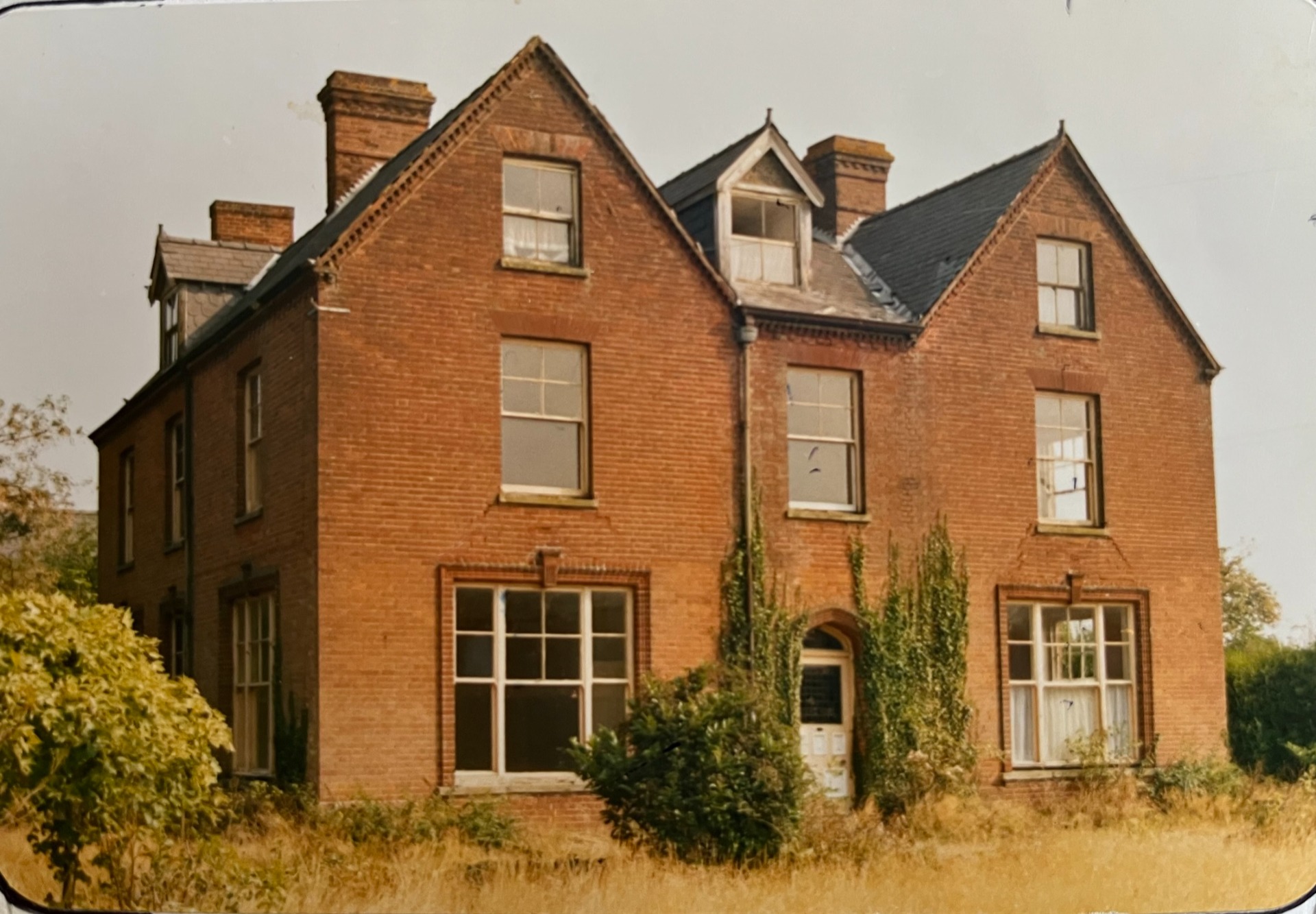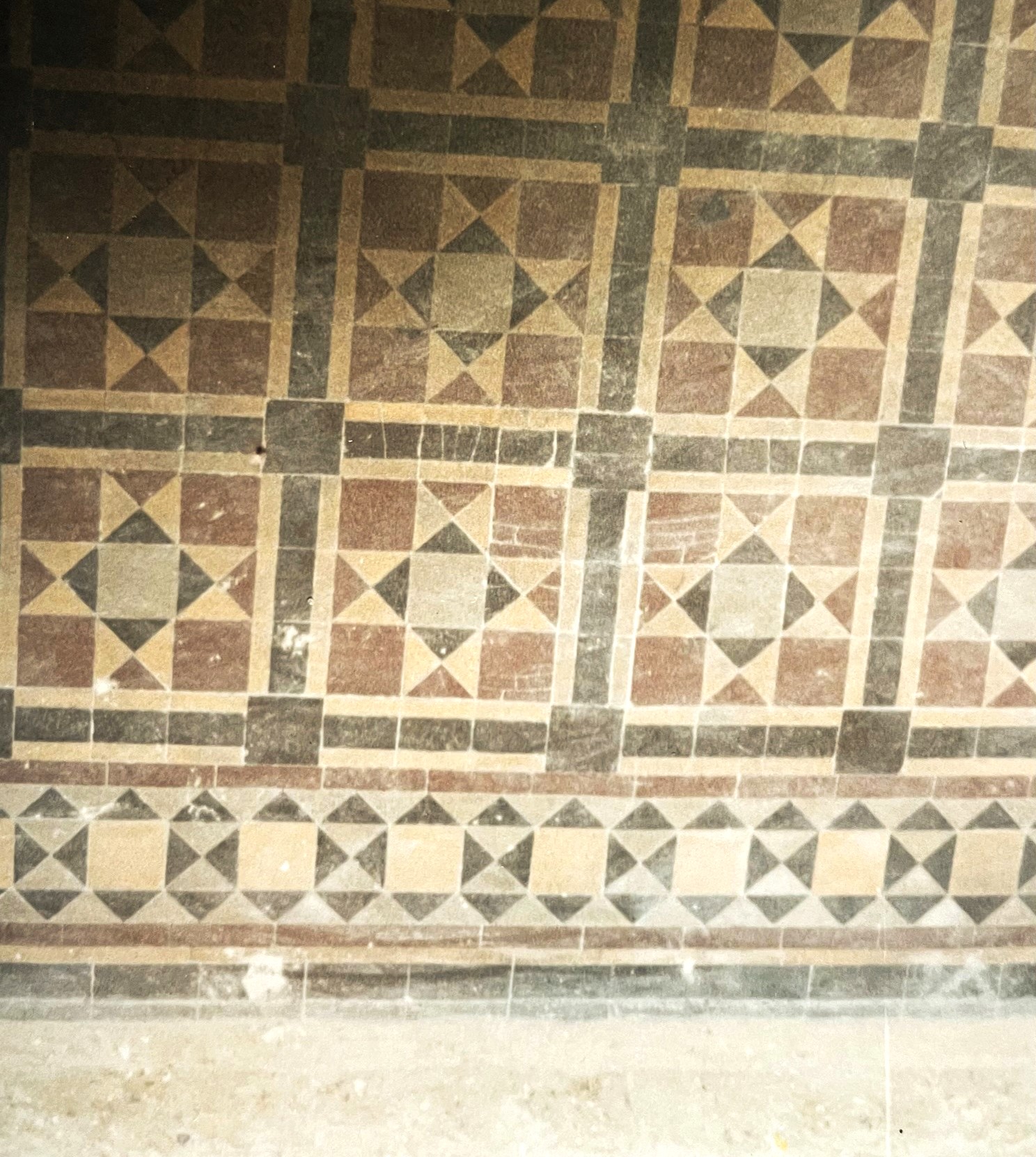
Lodge Farm
Hawkes Lane, Bracon Ash
Originally called The Beeches, the house was built by James Watts Church as a prestigious home for his growing family towards the end of the 19th Century. Listed by estate agents as 'Edwardian' it is in fact late Victorian and a brick in the wall of the house is inscribed J W C 1890. Descriptions state (correctly) that it is 'traditionally constructed with a clay lump core enclosed in a brick skin under a double pitched slate-covered roof'. High ceilings and tall sash windows bring in plenty of light.

When the house was built, James Church was a successful market gardener and adjacent to the house were barns and extensive glass-houses (see map below). A magnificent vineyard was housed in the largest glass-house, thought to be one of the largest in the country at that time. Signs of the extensive heating system still remain. However, competition from imported fruit that did not require heated greenhouses hit profits.
When the business failed under James' son Joseph, the big house and much of the land was sold and the family moved first to Great Yarmouth and later emigrated to Canada. The Berney family of Bracon Hall bought the house and some of the land and installed a tenant farmer. The Register of Electors lists George F Ringer (1929); then the Bowles family who were still there until 1939. The last tenant farmer was Richard Henry White (1904-1993) who moved to Lodge Farm with his wife Emlyn (1908-1987) and family from the edge of Dartmoor shortly after World War II began and farmed there for 50 years. Both are buried in Bracon Ash churchyard.

Richard & Emlyn's elder daughter describes Lodge Farm as:
'A large Victorian brick-built house of 15 rooms having high ceilings and huge windows. Kitchens were stone tiles, and the front hall had patterned tiles and stained glass in the front door. There were two large stairways, to the delight of visiting children who loved to run up one and down the other. In each of the main rooms were bell-pulls for summoning servants, who at one time had been quartered in the attic bedrooms. Without electricity, Tilley lamps lit the main rooms and we took candles to light us to bed. Water was supplied from a pump in the back yard - it's well never ran dry even in summers of drought. The outhouses in the yard included a milk parlour, and a wash-house for the family washing. What a labour to fill the copper, light the fire at its base, haul all the washing out of it, put it through the mangle, dry it and iron with a flat iron on the kitchen table. When I left for school on washdays, it was only with a bright smile that Mother bade me goodbye as she toiled in that wash-house. I used to cheer her ironing by reading her the Just William stories by Richmal Crompton, which we both loved.

'With those high ceilings and big windows, the house was impossible to heat. After frosty nights we would go from room to room, our breath steaming ahead of us, enthralled by the wonderful frost patterns on the windows....
'The garden had two large lawns, on one of which was turned into a tennis court. Mrs White created several flower-beds - she was a keen gardener and knew a lot about plants. Her daughter wrote, 'One field was lined with damson trees, another with morello cherries and in the orchard stood a very prolific Robin Pear tree. What a wonderful home our parents created for us at Lodge Farm.'
'Farming was considered essential war work, so Mr White was never called up, but labour was in short supply. As well as a herd of cattle, he turned areas over to arable farming and invested in new machinery. This included a milking machine to replace hand milking, thus easing the the job of milking the cows twice a day. His wife and children helped with the milk rounds and with feeding the hens, picking up eggs and washing them, and serving customers who came to the house for milk. The story of the evacuee families who came to live at Lodge Farm is told elsewhere.
'The two horses were replaced by a Fordson tractor, and later on a combine harvester was added. As well as increasing mechanisation, meaning new skills for farmer and labourers to learn, there was increased bureaucracy and regulation. Mr White employed a team of five, and his son Dicky when he left school. One of his workers was Maurice ('Monty') Norman, who was gladly given time off for football practices, games and interviews. He left to be a professional footballer with Norwich City and later with Tottenham, and played for England.
'There was no factory farming at Lodge Farm, and certainly no battery hens. The hens ran free in the orchard, until they had to go when fowl pest hit the area. Fortunately the farm was spared Foot & Mouth epidemics. Every animal was respected and given as good a natural life as possible - all the family loved nature.'

Mr White is remembered in Mulbarton for harvesting Mr Berney's land to the south of Cuckoofield Lane. Their son, also Richard (known as Dicky), moved to Mulbarton when he married a local girl but continued to help his father at busy times. It is said he hoped to be able to take over the farm when his father retired, but Mr Berney wanted to sell the house and land. His father struggled on after Emlyn died in 1987, but after 2 years and a major operation, realised it was time to retire. Dicky had to run down the farm's activities and arrange the sale of the machinery and equipment and all that had been built up over 50 years.

When Mr White retired, the house and land were sold separately. Mr Berney continued to farm the land, gradually selling off particular fields and Lodge Farm stood empty and unloved for many years. When Kenneth and Barbara Leslie purchased the property from Richard Trench Berney it was described as 'An imposing Edwardian Farmhouse, offering extensive accommodation, in need of complete refurbishment'.... Estate Agent speak for very large and very dilapidated! A number of out-buildings and glass-house remained (photos near top of this page). They set about a complete renovation and modernisation including replacing windows, and turned the neglected garden into grass.

The Leslies were Mormons and wanted the house to be become a home where needy people would be welcomed and they were 'open house' to many other Mormon families. The principle of generous hospitality established by Richard and Emlyn White lived on! The large house was used to host a number of child refugees, victims of abuse and homeless people - to the extent that local rumour called it a 'commune'! The garden parties and firework displays are also fond local memories. The Leslies moved elewhere in Norfolk and were followed by the Baker family who lived at Lodge Farm house between 2011 and 2021 and made a number of further improvements. Then it was on the market again....
The new owners are an architect and a sculptor, both with backgrounds in conservation. They are now carefully tending to the building and any items of historic interest, while also researching the house's history.
Many thanks to Beata and Anthony for providing many of the photographs and much of the information featured on this page.